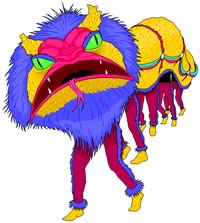|
|
 
Unit
2 - Theatre History
Module
1: Understanding Historical Context
Lesson
5 - World Theatre
Introduction:
Theatre
means different things in different cultures throughout the
world. When we in western nations think of theatre, we think
of a realistic play on a stage. In reality, theatre is far more
diverse than many people realize. The focus of this lesson is
that diversity, and the goal of the lesson is to experiment
with it.
Objectives:
- to use resonance and speak clearly
- to use voice projection
- to understand the historical and cultural influences on a
play
- to understand that theatre reflects the society that creates
it
- to continue to explore various presentational styles in their
dramatic presentations
Resources:
(pdf) Background notes
for theatre history unit, Sedna
(pdf) (an Inuit legend) and other stories, puppet material
(poster board, utility knife, thread or thin wire), a light
source like a projector, Puppet Play Self-Evaluation (pdf)
CELs:
C, CCT, TL
Components:
Creative/Productive, Cultural/Historical
 |
This
icon indicates an advanced print resource you can refer
to for more in depth research information. It has been provided
courtesy of Dr. Moira Day, University of Saskatchewan, Drama
Department. |
Activities:
Warm
Up:
Have your students complete the following warm up.
|
| Identify
the culture represented in the pictures below: |
(Thailand;
China; Africa; Latin America) |
1) |
2) |
3) |
4) |
Answer:
1 = Africa, 2 = Thailand, 3 = China, 4 = Latin America
Assignment 1 - Putting Storytelling into Practice
Story
Telling Traditions:
The oral tradition of storytelling is prevalent in cultures the
world over. Some very ancient stories remain with us today due
to the skills of certain story artists.
Telling
a story requires much from the performer:
Choose
a common fairytale from their own cultures and tell it to
another student. The role of the partner is to listen to the
story and make suggestions about flow, tone and pace. The
evaluation should be formative and informal. The purpose of
the evaluation is to prepare the individual for the second
assignment (15-20 min.)
"Advanced
Practice"
Retell the story using only movement.

Assignment
2 - Creating a puppet for Storytelling:
Students
should read the background information and complete assignment
steps on the assignment
page. The teacher may need to provide stories like Sedna,
from a variety of cultures, for student use. Following performance,
students should fill out the self-evaluation rubric and return
it to the teacher (30 min. to prepare, plus performance time).
Instructional
Strategies:
Role playing, Computer Assisted Instruction, Storytelling
Evaluation:
Matching question awareness check, formative peer-assessment
of storytelling, self-evaluation
of puppetry work, bonus opportunity
Alternative
On-Line Activity:
Tell
a story on an
audio
tape or streamed audio, create a shadow puppet and use a program
such as Power Point, Swish or Flash to create an on-line puppet
show.
Next
Lesson / Student Lesson
/ Previous Lesson
|
|












